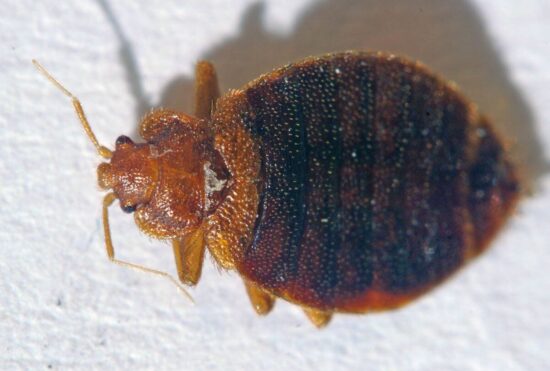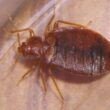Finding bed bugs in your home feels like a nightmare. These tiny bloodsuckers multiply fast, hide everywhere, and make sleeping impossible. When people search for quick fixes, rubbing alcohol often comes up as a DIY solution that seems simple and cheap.
The Science Behind Rubbing Alcohol and Bed Bugs
Understanding how alcohol affects bed bugs helps explain why this method falls short of expectations.
How Rubbing Alcohol Works as a Bug Killer
Rubbing alcohol, also called isopropyl alcohol, attacks bed bugs in two ways. First, it acts like a solvent that dissolves the waxy outer shell protecting the bug’s body. Once that protective layer breaks down, the alcohol works as a drying agent that removes moisture from inside the bug.
- Kill bed bugs and bed bug eggs
- Use spray as a spot treatment around bed frames, mattress seams/tufts/folds, and baseboards
- Kills even the toughest bed bugs
- The continuous spray Comfort Wand easily gets into hard-to-reach areas
When alcohol makes direct contact with a bed bug, the process happens quickly. The bug usually dies within 30 seconds of being sprayed. Most household rubbing alcohol contains either 70% or 91% isopropyl alcohol, and both concentrations can kill bed bugs they actually touch.
The problem is the “direct contact” part. Using rubbing alcohol to kill bed bugs only works if the liquid physically touches each individual bug.
What Research Really Shows
Scientists at Rutgers University tested rubbing alcohol on bed bugs to see how well it actually works. Their results were disappointing. Even when researchers sprayed alcohol directly onto bed bugs in controlled lab conditions, only about half of the insects died.
Think about what this means for real homes. In laboratory conditions where scientists could spray bugs directly, alcohol failed to kill 50% of the targets. In a real house, where bed bugs hide in tiny cracks and crevices, the success rate would be much lower.
The alcohol also stops working the moment it dries up. Unlike some pest control methods that keep killing bugs for days or weeks, alcohol provides zero protection once it evaporates. Bed bugs can return to treated areas within hours and face no danger at all.
The Serious Safety Risks
Using rubbing alcohol to kill bed bugs creates major safety hazards that outweigh any potential benefits.
Fire Danger is Real and Deadly
Isopropyl alcohol is extremely flammable. The liquid burns easily, but the invisible vapors floating in the air are even more dangerous. These vapors can travel across a room and ignite from heat sources you might not even consider risky.
In 2017, a woman in Cincinnati tried using rubbing alcohol to kill bed bugs in her apartment. She soaked furniture with alcohol, and when the vapors reached a nearby candle, the whole place went up in flames. Ten people lost their homes in that fire.
This wasn’t an isolated incident. Fire departments across the country have responded to similar blazes caused by people using rubbing alcohol for pest control. The Environmental Protection Agency specifically warns against this practice because of the fire risk.
When you spray or pour alcohol on mattresses, couches, and carpets, you’re creating a fire hazard that can last for hours until all the alcohol evaporates. Even small amounts can be dangerous if there’s any heat source nearby.
Health Problems for People and Pets
Breathing alcohol vapors can cause headaches, dizziness, and throat irritation. In small, poorly ventilated rooms, the concentration of fumes can become dangerous quickly. Children and pets are especially vulnerable to these effects.
Direct skin contact with rubbing alcohol can cause dryness, irritation, and even chemical burns with repeated exposure. The strong smell can also trigger breathing problems in people with asthma or other respiratory conditions.
Why Alcohol Fails as a Complete Solution
Even without the safety risks, using rubbing alcohol to kill bed bugs simply doesn’t work for complete pest elimination.
Bed Bugs are Master Hiders
Bed bugs didn’t survive for thousands of years by being easy to kill. These insects can squeeze into spaces as thin as a credit card. They hide inside mattress seams, behind electrical outlet covers, in furniture joints, and even inside electronic devices.
Trying to spray liquid alcohol into all these hiding spots is nearly impossible. Many of the places bed bugs love to hide are completely inaccessible to sprays or liquids. Even if you could reach some of them, you’d never get them all.
Female bed bugs can lay up to 250 eggs during their lifetime. Miss just a few bugs or eggs during treatment, and the problem starts all over again within weeks.
Bugs Fight Back and Spread Out
When bed bugs sense danger, they don’t just sit there waiting to die. They scatter and run to new hiding spots. Using rubbing alcohol to kill bed bugs can actually make an infestation worse by spreading bugs to parts of your home they hadn’t reached before.
The alcohol spray can also push bugs deeper into mattresses, furniture, and wall voids where they become even harder to reach. What started as a problem in one bedroom could quickly spread throughout your entire house.
Bed bug eggs present another major challenge. These eggs have a tough, waxy coating that protects them from alcohol and many other treatments. Even if the alcohol kills adult bugs, the eggs can still hatch days or weeks later.
- Kill bed bugs and bed bug eggs
- Use spray as a spot treatment around bed frames, mattress seams/tufts/folds, and baseboards
- Kills even the toughest bed bugs
- The continuous spray Comfort Wand easily gets into hard-to-reach areas
Better and Safer Alternatives
Professional pest control experts have developed much more effective methods that actually eliminate entire bed bug populations.
Heat Treatment Works Best
Heat is bed bugs’ biggest weakness. These insects cannot survive when temperatures reach 118°F and stay there for 90 minutes or longer. Professional exterminators use special heating equipment to raise room temperatures to 140°F or higher, ensuring that heat reaches every hiding spot.
For homeowners, high-heat washing and drying can eliminate bed bugs from clothes, bedding, and other washable items. Set your dryer to the highest heat setting and run items for at least 30 minutes.
Steam cleaning also works well for treating furniture, mattresses, and carpets. The steam needs to reach at least 130°F to kill bugs on contact. Move the steamer slowly to make sure the heat penetrates into fabric and cracks where bugs might hide.
Smart Pest Management Strategies
The Environmental Protection Agency recommends something called Integrated Pest Management, or IPM. This approach combines several different methods to attack bed bugs from multiple angles.
IPM starts with thorough inspection to find all the areas where bed bugs are hiding. Then it uses a combination of heat treatment, targeted pesticide application, physical removal, and prevention measures. This comprehensive approach is much more effective than relying on any single treatment method.
Professional pest control companies also use specialized monitoring equipment to track the success of treatments and make sure all bugs are eliminated before the job is considered complete.
Simple Non-Chemical Methods
Several non-chemical approaches can help reduce bed bug populations when used as part of a larger treatment plan. Regular vacuuming removes bugs and eggs from surfaces, but you need to immediately dispose of the vacuum bag in a sealed container.
Mattress and box spring encasements create a barrier that traps any remaining bugs and prevents new ones from getting in. These special covers have zippers that close tightly and material that bugs cannot bite through.
Diatomaceous earth, a powder made from fossilized algae, can kill bed bugs by damaging their outer shell. Unlike alcohol, this powder keeps working for weeks and is much safer to use around children and pets.
When to Call Professional Help
Some bed bug situations are simply too big or too complicated for DIY methods to handle effectively.
Signs You Need Expert Help
If you keep finding new bed bugs after trying treatments, the infestation has probably spread beyond what you can see. Multiple rooms with bug activity, recurring bites, or blood spots on sheets in different areas all indicate a serious problem.
Apartment buildings and condos require special attention because bed bugs can travel between units through walls and shared spaces. Treating just one unit while ignoring neighboring apartments rarely succeeds.
Families with young children, elderly members, or anyone with health conditions should consider professional treatment to avoid exposure to potentially harmful DIY methods.
What Professionals Bring to the Job
Licensed exterminators have access to powerful heating equipment that can treat entire rooms or houses at once. They also use professional-grade pesticides that aren’t available to consumers but are much more effective than store-bought sprays.
Professional inspection techniques can find infestations that homeowners miss completely. Experts know exactly where to look and what signs to watch for. They can also determine how far the bugs have spread and create treatment plans that address the entire problem.
Most pest control companies provide guarantees for their bed bug treatments and will return for follow-up visits at no extra charge. This ongoing support is crucial because bed bug elimination often requires multiple treatments over several weeks.
Prevention Keeps Problems Away
Stopping bed bugs from getting into your home is much easier than getting rid of them once they’re established.
Travel Smart to Avoid Bringing Bugs Home
Hotels and other lodging places are common sources of bed bug infestations. Before settling into any hotel room, check the bed carefully for small brown or red stains on sheets and pillowcases. Look along the mattress seams and behind the headboard for live bugs or dark spots.
Keep luggage in the bathroom while you inspect the room, since bed bugs rarely infest bathrooms. If you find any signs of bugs, ask for a different room that’s not next to the infested one.
When you return home from travel, wash all clothes immediately in hot water and dry them on high heat. Inspect luggage carefully before bringing it back into bedrooms.
Home Protection Strategies
Regular inspection of beds, furniture, and common hiding spots helps catch problems early when they’re easier to treat. Check mattress seams, box springs, and bed frames monthly for signs of bugs.
Reducing clutter in bedrooms eliminates hiding places and makes inspection easier. Seal cracks and gaps around baseboards, electrical outlets, and furniture to reduce the number of places bugs can hide.
In apartment buildings, work with property management to ensure that neighboring units are also inspected and treated if necessary. Bed bugs can spread through shared walls, so building-wide cooperation is often essential for complete elimination.
The Bottom Line on Alcohol and Bed Bugs
Research clearly shows that using rubbing alcohol to kill bed bugs is both ineffective and dangerous. The method kills only about half the bugs it touches directly, provides no lasting protection, and creates serious fire hazards that have already caused house fires and displaced families.
Professional pest control methods like heat treatment and integrated pest management provide much better results without the safety risks. These approaches address the entire infestation, including hidden bugs and eggs that alcohol cannot reach.
If you’re dealing with bed bugs, skip the risky DIY alcohol treatments and focus on proven methods that actually work. Start with high-heat washing and drying for immediate items, then contact licensed pest control professionals for comprehensive treatment.
Don’t let desperation lead to dangerous choices. Bed bug elimination takes time and patience, but using the right methods will solve the problem safely and permanently. The small extra cost of professional treatment is worth avoiding the much larger costs of fire damage or ongoing infestations that never get fully resolved.



